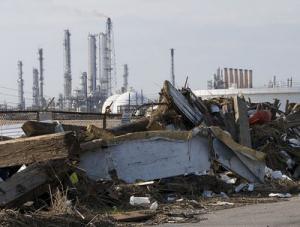Coastal resilienceU.S. coastal communities face increasing risk of compound floods
In 2010, 39 percent of the U.S. population lived in coastal communities — a number which is expected to continue to increase in the next five years. The confluence of storm surges and heavy precipitation can bring dangerous flooding to low-lying coastal regions, including major metropolitan areas. A new study of the United States coastline has found the risk of such flooding is higher on the Atlantic coast than the Pacific, and the number of these compound events has increased significantly in many major cities in the past century.

Damage done by combined flooding and rain // Source: commons.wikimedia.com
The confluence of storm surges and heavy precipitation can bring dangerous flooding to low-lying coastal regions, including major metropolitan areas. A new study of the United States coastline by an U.S.-German team of researchers has found the risk of such flooding is higher on the Atlantic coast than the Pacific, and the number of these compound events has increased significantly in many major cities in the past century.
The research team was led by Thomas Wahl, a postdoctoral researcher at the University of South Florida and University of Siegen, Germany, and involved four other researchers, including Shaleen Jain, a University of Maine associate professor of civil engineering. Their findings were published in the journal Nature Climate Change.
“The 2013 Infrastructure Report Card issued by the American Society of Civil Engineers assigned the following grades: levees (D-), ports (C), wastewater (D), roads (D). With this daunting perspective in mind, we sought to quantify the frequency of occurrence of compound flood events, as gleaned from the historical record. We were seeking to learn the spatial patterns of the risk of compound flooding, as well as their variability over the past century,” says Jain.
A UMaine release reports that similar concerns were raised last month by the U.S. Government Accountability Office (GAO). In a 22 July 2015 report, Efforts to Assess the Impact of Extreme Weather Events, GAO reviewed U.S. Army Corps of Engineers efforts to integrate changing risk from weather extremes into planning and operations of water resources infrastructure projects. The report concludes, “As the frequency and intensity of some extreme weather events are increasing, without performing systematic, national risk assessments on other types of infrastructure, such as hurricane barriers and floodwalls, the Corps will continue to take a piecemeal approach to assessing risk on such infrastructure.”
The researchers determined that compound events are linked to weather patterns that favor storm surges and heavy rain and snow. For instance, the research team found that storm surges hitting New York City are accompanied by heavy precipitation when a high-pressure system stretches from Newfoundland south over the North Atlantic, where moist air is transported into the low-pressure system.
New York is just one of the major coastal cities with populations over one million people. In 2010, 39 percent of the U.S. population lived in coastal communities — a number which is expected to continue to increase in the next five years, according to the National Oceanic and Atmospheric Administration (NOAA) in its “State of the Coast” report.
Knowing the probability of concurrent storm surges and heavy precipitation could reduce high-impact risks, providing relevant information for design of infrastructure, and careful consideration of structural (levees, barriers, etc.) and non-structural (forecasts, early warning systems and natural barriers) measures to mitigate impacts.
The researchers used hourly storm surge data from thirty tide gauges along the U.S. coastline, and daily precipitation averages from nearby NOAA National Climatic Data Center stations. Complex integrated modeling that includes ocean-atmospheric processes as storm surge, rainfall and river discharge will be needed to understand the detailed nature of local impacts, and possible linkages to climatic phenomena.
— Read more in Thomas Wahl et al., “Increasing risk of compound flooding from storm surge and rainfall for major U.S. cities,” Nature Climate Change (27 July 2015) (doi:10.1038/nclimate2736)
